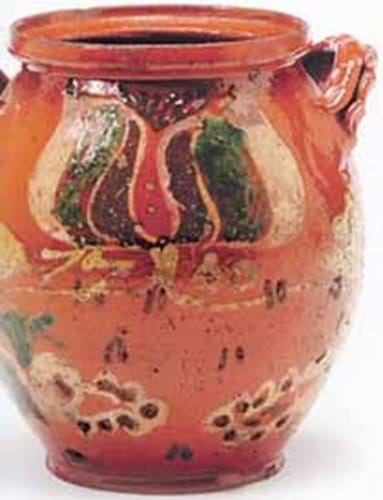
A continuation of a European tradition in which a mechanically printed piece would be enhanced with added illumination, and more commonly associated with legal or religious documents, these manuscripts took on a more personal nature in the hands of American emigrants. The most common documents now found in this field are the Geburts und Taufschein, birth or baptismal certificates, that were so important to the Lutheran and Reformed Church families of Pennsylvania. Much fraktur was the work of 18th and 19th century schoolmasters in the church-community school setting and many of the pieces were made as rewards or as an encouragement and admonition to students in the German-language schools.
The Rev. George Geistweite, the maker of this ink-on-paper example of the art form, is known to have worked only two frakturs - both made during the summer of 1801 for the Bower family of Centre County, Pennsylvania.* These are both very ornate pieces, populated with human figures, horses, double eagles, hens, chicks, lions and stylized flowers, and are quite unusual in that their themes are secular. The example seen at Freemans has in its central panel a verse from a 'Hymn to the Nightingale', depicted in the "fractured" or broken German typeface from which the form takes its name.
Bidding in the room opened at $50,000, and three telephone bidders quickly pushed the price above the previous record for a fraktur of $180,000, but it was a bidder in the room who finally prevailed at $330,000 (£186,440).
Pennsylvania redware, much of which came to auction from the estate of a Reading, (PA) collector - as did the fraktur - brought some surprising prices. Redware, a coarse, lead-glazed earthenware made from the mid-18th century onwards, has become one of the more highly collectable areas in American ceramics, reported the auct-ioneers, "despite the quite pedestrian origins of the pieces".
Leading the Freemans entries was a glazed and slip-decorated redware jar, dated 1790, that was unusual in having very colourful painted deco-ration. Estimated at $4000-6000, the jar soared to $48,000 (£27,120), with the hammer falling to a telephone bidder.
The sale also yielded records for redware animal figures. The record was first broken when a 7 1/4in (18cm) high figure of a dog with a basket of fruit in its mouth reached $13,000 ($7345), but was immediately exceeded when the following, a 5 3/4in (14.5cm) high figure of a cat with black stripes was bid to $15,000 (£8475). That same price was paid for a large, oblong slip-decorated redware dough tray.
Among the clocks, a Chippendale style walnut longcase of the third quarter of the 18th century, the steel chapter ring inscribed by Duncan Beard of Appo-quinimink, Delaware, was sold at $48,000 (£27,120).
* The only other known Geistweite fraktur is in the Titus C. Geesey Collection at the Philadelphia Museum of Art.




